A sweet desire for happiness from Spain
Monday, December 31, 2012
Today is the last day of this year, 2012, and I want to wish you the best for the next year.
Tonight, I will dinner in a brother in law of mine´s home and I will take a cake, filled with cream toast.I have thought I should like to wish you a good new year, showing you this cake, cooked by my friends from the pastry "Pan-Dul", in Algeciras (Cadiz).Here it is:

It seems to be a Bunch of Grapes.....
Kind regards and Happy New Year 2013 --as my last picture in 2012 says--.
Sponsored by Costaluz Lawyers.
Please click down here:
.jpg)
 0
Like
Published at 6:23 PM Comments (0)
0
Like
Published at 6:23 PM Comments (0)
The Sleeping Beauty in Spanish
Saturday, December 29, 2012
I have just known a very nice project in order to fight children poverty.
Several famous spanish people (actors, actresses, singers, sportmen and others) have made a video, telling several famous stories.Between them, I want to show you the video made by Belen Rueda (a young but very famous actress in Spain).Please click down here and at the end of the video, read what she told, but translated by me:
This is the story of a boy who could not sleep.It was a long, long time ago. Nobody knows exactly when or where, but the truth is that the child did not know the sleep. So that school will put more duties than others ...., many more, to arrive home exhausted, but no .... There was no way. Then, magicians, sorcerers, with their concoctions, with their potions, also tried, but none succeeded in the child could sleep .... none.
And then, the boy's grandfather, who was the elder, recalled that there was a young girl, who had been so long asleep by the enchantment of a witch. She thought she was the only person who could help the child ..... the only one .... because nobody like her knew what was sleeping and sleeping.So that the family addressed the Princess Castle, but ... the doors were locked ....; clear ... so long sleep was normal for the Princess not to stop travelling. So that they decided to write the address of the child, on the wall of the princess to go to see him on her return. It was the first time you wrote a message on a wall ... -- even centuries later became standard practice--.
After that, they spent many evenings ..., many sleepless nights, until one afternoon appeared the Princess. Then the family rushed to tell her what was happening with the child. She said: "You can leave me some time alone with the small? ". And she did. After only half an hour, the princess went quietly and for silence, because the child finally had fallen asleep, for the first time. Amazed, the family asked: "But how did you get it? ...., What trick, what secret or what enchantment spell or what ...?". "A spell ....?. No, there was no need for any of that .... it is something much simpler: I sat next to him and I told him, softly, like a witch left me asleep and woke me a Prince”.
The locals asked the Princess to write that story, in order to tell their children when they could not sleep. She called this tale "Sleeping Beauty" and, thereafter, were written countless stories in many languages and in all parts of the world. And for what? .... So that no child ever ... none ... was left with sleep.
Enter and assists in the fight against child poverty.
Kind regards,
Luis.
Please click down here:
.jpg)
 0
Like
Published at 9:07 PM Comments (0)
0
Like
Published at 9:07 PM Comments (0)
A little new chorus in Spain
Wednesday, December 26, 2012
The Little Singers choir is inserted within the organization of the Youth Orchestra and Chorus of the Autonomous Community of Madrid (JORCAM), created to contribute to the training of young musicians from Madrid in a framework of high quality professional learning and technical artistic. Its main objective is to expand and develop their musical knowledge in order to facilitate its members access to future professional orchestras through knowledge and practice of choral and orchestral repertoire in all its facets. This project aims to complement teaching and artistic musical studies art education centers, preparing the young performer in a field of standards and quality music and providing a path for future career. Small Singers, made up of children aged between six and thirteen years, he has performed in venues and festivals such as the Royal Theatre, the Canal Theatres, National Auditorium, Auditorium CaixaForum, the Festival of San Lorenzo of El Escorial or the International Festival Peralada. Among his recent performances highlight the participation in several productions of the Theatre Royal and The Knight of the Rose R. Strauss, J. Werther Massenet, Krol Roger K. Tosca and G. Symanovsky Puccini.
Yesterday, 25, the Little Singers (Los Pequeños Cantores) acted in Madrid, in the Royal Theatre.
This chorus is directed by Ana González and with Laura Scarbó, on the piano.
Ana González gets these children have discipline, despite their youth.
Ana thinks that “White voices” are by children, because those voices do not vibrate.
I want to show you an acting by these Little Singers.It happened in the Foundation “Juan March”, the last May – 2012:
"The Little Singers of the JORCAM in the Foundation Juan March", Madrid, Spain.
Kind regards,
Luis.
Sponsored by Costaluz Lawyers
Please click down here:
.jpg)
 0
Like
Published at 6:12 PM Comments (0)
0
Like
Published at 6:12 PM Comments (0)
Rescue with the cold of Spain
Saturday, December 22, 2012
Now, when many people are starting or thinking to start their Christmas Holidays on a mountain –skiing or climbing the mountain--, I want to pay tribute to the High Mountain Group of the Civil Guard, in Spain, who usually make an average of 100 rescues a year.Although sometimes the number of rescues grow up --for example, this year, 2012, this Group of the Civil Guard, made 345 rescues, only in the province of Huesca (Aragon Pyrenees, north-east of Spain)--.
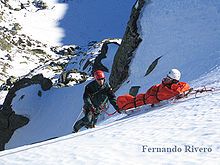
The GREIM (Group of Rescue and Intervention in Mountain) from Barco de Avila
.jpg)
.jpg)
My sincere congratulations to this Group, who risk their lives every day, in order to save another lives.

Amazing how they risk their lives for everyone......
This year there were 19 persons dead in mountain accidents.The members of this Group say that not everybody go prepared to mountain.
A member of this team says to wear a thermal shirt, stuck to the skin, and that is very important to wear a hat, because the cold causes you to lose 70 percent of your body heat through your head.
This same member says that when ice is blue, you may think that it is quite attached to the floor of the mountain.He also says that is very important to place two ropes above the ice wall, to be safe in case of a falling by the climber.And he says that you have to be very careful if there are small landslides of ice rubble.
Another member of this team carries a thermos tea with sugar.He also carries heaters to his feet and hands -- to prevent freezing--.
Another member of the rescue team is "avalanche dog handler", in Panticosa (Pyrenees of Aragon.North-East of Spain).

Although thanks to God I have never needed the help of this special Group of the Civil Guard –neither my family and friends--, I am proud to be Spanish like the members of this team and like all the Spanish members of the Civil Guard.
Kind regards,
Luis.
Sponsored by Costaluz Lawyers.
Please click down here:
.jpg)
 0
Like
Published at 12:05 AM Comments (0)
0
Like
Published at 12:05 AM Comments (0)
Spanish quality shoes in the world
Tuesday, December 18, 2012
In 2011, 125 million people wore spanish shoes worldwide. This is because Spain is the second largest manufacturer and producer of quality shoes in the European Union; and it is among the world's top 10.
In Alicante (East of Spain), it is produced the 60 % of the domestic footwear.
Concretely, in Villena it is produced the most of the children´s shoes.
In Elda are produced the ladies´ shoes.
And in Elche, are produced the ladies´s and gentlemen´s shoes.
There come mainly foreing, for example when they come for holydays. It has much advantage for them because, for example, if in stores shoes cost 120 Euros, here cost 80.
In the Business Park of Elche you can find any brand on the market. Here is concentrated almost all footwear of Alicante: 170 factories, 6.000 employees and 30 stores.

A shoe store in the Business Park of Elche, Alicante, East of Spain
Quality Shoe means: always a leather shoe, both cutting and lining.And the price above 80 Euros.
The countries which much more buy our shoes are: France and Germany –in the European Union— and: USA, Mexico and Russia. Asia is emerging now too.
Spain has 30% of domestic consumption of footwear and 70% export.
Japanese think that Spain has good products and competitive prices.
The Manager of a factory in Elche says that “Spain has to offer betting on Spain Brand consolidated”.He also says that they have their own leather factory.In the factory where they receive the leather, there are 150 persons, who work trying to manually shoe.
Fortunately Spain takes 6 years betting on the label "Made in Spain".
Best regards,
Luis.
Sponsored by Costaluz Lawyers.
Please click down here:
.jpg)
 0
Like
Published at 11:41 AM Comments (5)
0
Like
Published at 11:41 AM Comments (5)
The value of enterprising young people in Spain
Friday, December 14, 2012
Today I wanted to write about the wonderful region in Spain, named La Rioja (North-west of Spain) –like its famous wine--, because this year that is finishing, 2012, its capital (Logroño), has been declared “Capital of Spanish cuisine”.But, I prefer to talk about another interesting matter related to La Rioja and I will talk about Logroño in another post.
I have just known that two very young Spanish women, from La Rioja,have received an award at the European Union Contest for Young Farmers.It has been an “European Award to sustainable agricultural project”.
The protagonists of this project are two sisters, Ana María and Raquel Pérez Sáenz, from Quel (La Rioja). They are the members of the Group AN, who run the farm "Poultry Rioja", located on Quel, and they have received this such important award in recognition of the launch of a farm poultry.
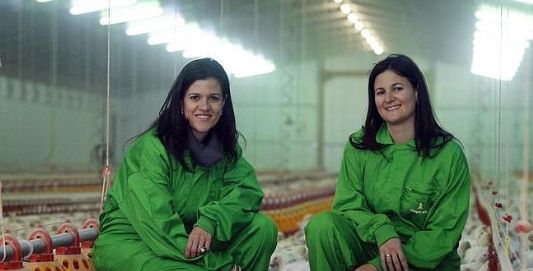
"Ana María and Rachel in their farm", Quel, La Rioja, North-west of Spain.
The President of the Government of La Rioja, Pedro Sanz, acknowledged the "effort" and "work" of these livestock from La Rioja.
Sanz has indicated that this award is the result of "effort and work" that these two entrepreneurs from La Rioja have devoted for implementation of their farm, which stands out for the high automation of its facilities, ensuring the welfare of animals He has also highlighted, in a note, the "efforts" of the two, who have successfully taken the "witness" of their father to expand the business opportunities of the livestock farm, which began operating in 2011 and has 270.000 chickens.
He highlighted that Ana María Pérez Sáenz and Raquel are a "shining example" for young people and women who want to actively join the sector, "strengthening" the farming and ranching in La Rioja.
These two sisters, told Efe in Brussels, said their chicken farm stands, among other factors, high automation in their facilities and to ensure animal welfare and landscape integration. . In this sense, Ana Maria and Rachel explained that, for example, they have placed such blue light so that the chickens do not have stress and green light to feel like eating.
Although the farm began production in February 2011, the idea came about seven years ago, in which they carried out the laborious preparations for its implementation.
Currently, the farm has nine industrial premises, which are bred about 270.000 chickens, and the goal is to complete the project with the launch of two additional industrial premises, explained the livestock from La Rioja, who shared the prize with a project in Bulgaria.
I am so glad that there are people willing to brave to stay in Spain, to lift this country as important, in the midst of a grave crisis.
Kind regards,
Luis.
Sponsored by Costaluz Lawyers.
Please click down here:
.jpg)
 0
Like
Published at 1:42 PM Comments (0)
0
Like
Published at 1:42 PM Comments (0)
Spain conquers the world with tapa
Wednesday, December 12, 2012
Spain is the fifth country in the world, with “Michelin Star”.And between the eight best restaurants in the world, three of them are from Spain.
In the International School of Gastronomy “Fernando Perez”, in Valladolid (North-west of Spain), there are 65 foreigners people, that come to learn how to cook in Spain.Daniel Méndez is their teacher; he was the winner of the National Contest of tapas 2011, with the tapa “Good news of our land”.
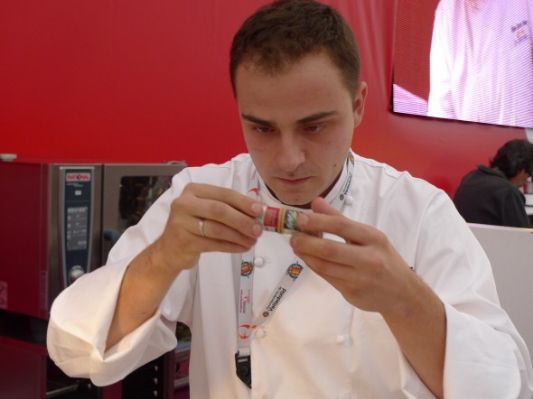
Daniel Méndez cooking his original tapa
Daniel explains that this tapa means that if we compare the above with the news below, the above news are: good cheese, good meat, good news for Gastronomy, because our cuisine triumphs beyond our borders.This tapa is made with a rice paper and inside it Daniel put a piece of meat and a little bit of cheese.Arround the paper –which seems to be a sheet of newspaper— he rolled an edible gum.
Daniel also explains to his students how to cook this tapa.In the kitchen of this School, with Daniel, is Fernando (the head of food and beverages in a hotel chain), who called several chefs from various hotels in the chain: Panama, Puerto Rico, United States ....., together, because he says that "Spain is a gastronomic reference in the world " and said to bring them to personally see Spanish products and to see how to cook here.Then, these chefs will cook the tapas which they learn here, in their own countries.Fernando says that Spanish tapas are known in cities like: Quebec (Canada), New York (USA), San José (Costa Rica) and two countries: Panamá and Colombia.
One of these chefs –who comes from a hotel in Panamá— says that “Coming to Spain was a dream” for him.
The Director of this International School of Gastronomy says that they sought students between 1.800 Schools in all the world; but there were 240 interested; and the International School chosed only 14 students, to compete in the International Competition of Tapas.Angel, the Director, says that 800 students have come to this School this year; and the number of students is growing. Some students pay around 6000 or 7000 dollars for 30 days, throughout Spain, in the best restaurants, in a VIP class; and there are people who pay 500 or 600 dollars a week -- but it is cheap, for what it offers --.
A group of these students come from “The Culinary Institute of America”, the best Cooking School in the world.It is in High Park, in New York (USA).They only went to Italy and to California; but, since 4 years ago, they also come to Spain.Here, they have cultural tours, gastronomic tours, workshops with Spanish chefs and, above all, they see are products.These students will get good grade in their Universities, cause of this special cooking course, in Spain.
One of the Spanish chefs, who collaborate with these School, says that, that fortunately Spain's image abroad has changed because before talking about our gastronomy as "Spanish gastronomy" (cooked food as in several countries of South America.) But now they see that Spain has a lot of quality gastronomy .
Kind regards,
Luis.
Sponsored by Costaluz Lawyers.
Click down here:
.jpg)
 0
Like
Published at 11:52 AM Comments (1)
0
Like
Published at 11:52 AM Comments (1)
Vertical garden in Spain
Monday, December 10, 2012
In Spain, there is a company, that designs “vertical gardens”.The name of the company is PAISAJISMO URBANO (Urban Landscaping) and they have a website (http://www.paisajismourbano.com), where they explain the following:
“ From Urban Landscaping, we offer you our experience in designing vertical gardens, in a bid to create urban environments that highlight areas for its beauty naturaly serve to recall the ancient gardens of Babylon.
Welcome to the website of Urban Landscaping, a company dedicated to the creation and design of vertical gardens and roof gardens.
We invite you to browse through our web site, where you can meet our professional, services, as well as a sample of the gardens of Babylon, which has shaped our team. Urban Landscaping, concerning the development of vertical gardens and rooftop projects naturation, born with the maxim of offering an innovative concept of sustainable and coherent landscaping. Putting into practice the experience in the treatment of facades and vertical gardens design, the Urban Landscaping team has combined all his skills and knowledge, leading to incredible parkland, reminiscent of the ancient gardens of Babylon.
As experts in the making of green walls and vertical gardens, in Urban Landscaping we believe in a greener and attractive city, providing as a value-added color and nature inhabiting any building and roof ”.
Now, I am going to show you an example of Vertical Garden in Madrid; here you have a picture of the vertical garden created by the French botanist, Patrick Blanc, on the facade of the building of CaixaForum:
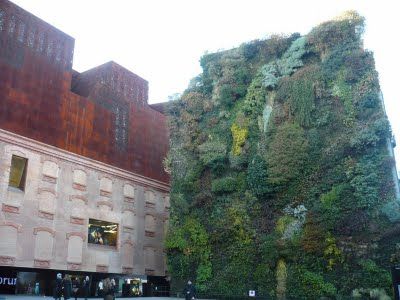
The central building of CaixaForum, Madrid, Spain
Contamination and pollution have become one of the biggest problems of the big cities. The citizen is subjected to throughout their day to day to a number of harmful particles directly related to the frenetic pace of life in cities where traffic and factories us away, increasingly, a life model healthy.
This is a picture that I like very much.I think that house is now very nice and more healthy, with that vertical garden:
.jpg)
Thus it becomes absolutely necessary to give our cities parks, gardens and green spaces which contribute not only to reducing CO2 and give us cleaner air, but let the citizen Breathe easy disconnecting from the madding crowd. However, the square footage available free cities are shrinking and therefore, the possibility of creating new green spaces are scarce. The solution came a few years ago with the recovery of green roofs, an ecological measure present in the architecture for centuries but has now taken on a new momentum. The next step was the vertical gardens, is about harnessing the walls of buildings to create new parkland fixing CO2, achieve lower temperatures promote biodiversity and to become habitat for certain species of flora and fauna.
.JPG)
Vertical Garden on the Municipal Children.Málaga, South-East of Spain.
Terapia Urbana (Urban Therapy) is the only one company, in Seville, that develops vertical gardens.This company born around a year ago, as an evolution of a research project at the University of Seville. Its pilot experience is in the School of Agricultural Engineering (ETSIA) in whose lobby is a pilot vertical garden from 2006, which shows the behavior of the plants, their needs and their contribution to improving the environment, all monitored using a remote control software devised by the company Idener, with which collaborates Urban Therapy for optimum operation of the vertical gardens.
.JPG)
Vertical Garden installed by Terapia Urbana, at ETSLA.Seville, South of Spain.
Urban Therapy bets for an Urban Naturalization as an instrument of sustainable architecture to improve environmental quality and energy efficiency in buildings, or what is the same, returning to their original nature. And how is it done? Using two types of gardens, vertical garden liabilities and assets, a creation of art patented by Terapia Urbana. The first case is to install a structure attached to the building that serves as a basis on which to install the plants. The active vertical garden also allows free air circulation within the structure that holds the garden which helps to reduce the outside temperature, the hot air passes through the filter of garden plants by evaporating and cooling the atmosphere thanks to its capacity of biofiltration, acting as a scavenger of volatile organic contaminants.
The plants were placed in a mesh formed by inorganic fibers, the secondary land is developed as the plant roots through the bracket. The garden is completely monitored at all times that the salts are controlled and the pH of the water tank, distributing in irrigation nutrients necessary to allow development.
The benefits of vertical gardens are many: improved air quality, produce oxygen, increase the aesthetic quality of the environment where they are built, fixed greenhouse gases, reduce the heat island effect ... benefits and advantages that justify long term installation costs. Sustainable architecture is an extra cost, but ultimately, cities will have to take this type of facility as natural and everyday if they want to offer a good quality of life and to remain habitable. The future of the building goes through sustainability and this is only a first step. Moreover, from Urban Therapy assert that such gardens in no way affect the structure of the building as it installs a protective chamber that prevents moisture and plant growth cause any damage to the wall that supports it.
Madrid was the first Spanish city in creating vertical garden, at CaixaForum, in 2007.After that, it was created in Zaragoza and after in Barcelona and Malaga.
Cities with very hot and heavy pollution, such as Sevilla, need this new system, to improve their quality of life …..
Best regards,
Luis.
Sponsored by Costaluz Lawyers.
Click down here:
.jpg)
 0
Like
Published at 12:22 PM Comments (0)
0
Like
Published at 12:22 PM Comments (0)
Spain: World leader in Solar Thermal Energy
Saturday, December 8, 2012
Very close to the village Fuentes de Andalucía (Seville), there is a solar thermal plant, who provides electricity to 28.000 homes.
In Spain, there are 40 plants like this one.
The plant of Fuentes de Andalucía has an area of 200 hectares. This is the only solar thermal plant with central tower receiver, which uses these reflections.
This plant has aroused a great international interest, because it is the only one solar thermal plant in the world, that is abble to produce energy 24 hours in a day –produces energy by day and night--, 365 days in a year.Therefore, Spain is world leader.
Here there are 200 hectares of heliostats plates; they are conventional mirrors; but each one is directed towards the sun; so, we are by reflecting 30 football fields to a smaller area; then, we concentrate up to 1000 times the solar energy. The light reflected from the plates towards the central tower heates some salts, to 565 degrees, and it produces water vapor.That thermal energy is converted in electricity, when it is decided by the company.
The Director of this plant says that in South Africa there are several spanish companies building a plant like this one in Seville.
For Spain, these plants have meant the creation of 23.000 jobs, in the last 3 years.From here, the Spanish companies, are going to build in Marocco, South Africa, Persian Gulf…..

"Fuentes-de-Andalucia-Spai-001", Fuentes de Andalucía, Seville, South of Spain, by M1K3Y, at flickr.com

"Four Solar heliostats plates".
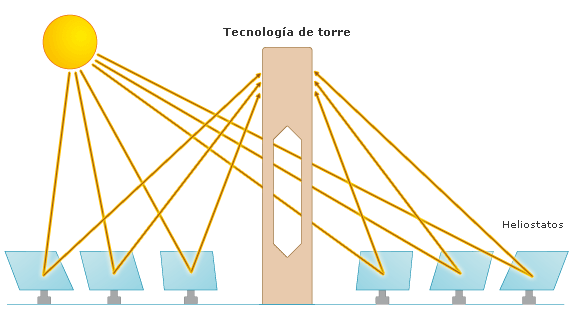
Explanation of the reflection from the sun towards the tower.
Another solar thermal plant is in Sanlúcar la Mayor (Seville); its company builder is ABENGOA, that now is building the biggest plant in the world and here (in Sanlúcar) has built the biggest plant in Europe.In this plant, there are 4 towers.And the energy produced will arrive to 150.000 homes.
.jpg)
"Solar thermal plant", Sanlúcar la Mayor, Seville, South of Spain.

"One tower in the Solar Thermal Plant by Abengoa", Sanlúcar la Mayor, Seville, South of Spain.
A manager of Abengoa says that, in 2050, among 95% and 98% of electricity will come from renewable sources.And he also says that we could produce more energy, in one hour, than what we consume in one year.
Within 6 months, the biggest solar thermal plant in the world will be completed, in Arizona (USA), by Abengoa.
If you want having more information, about solar plates, you can read an old post that I put, the last August-17, named “The Solar Energy in Spain”.Here it is.Please click down here:
http://www.eyeonspain.com/blogs/mgmt/editpost.aspx?blog=luislopezcortijo&post=7596
Best regards,
Luis.
Sponsored by Costaluz Lawyers.
Click down here:
.jpg)
 0
Like
Published at 1:14 AM Comments (0)
0
Like
Published at 1:14 AM Comments (0)
The Patios in Córdoba (Spain): Intangible Heritage of Humanity
Friday, December 7, 2012
Yesterday, finally after two years, The United Nations Educational, Scientific and Cultural (UNESCO) has just named the Patios (courtyards) of Córdoba “Intangible and Cultural Heritage of Humanity”.
The Andalusian tradition of that city where the locals celebrate the spring by opening their homes flowering.
The Andalusian ritual, which dates back to Roman times, earned his entry into the list of the UNESCO on the second attempt, after the application was rejected on last year.
The group had recommended assessment prior registration of that celebration, which opened to the public neighbors patios and balconies adorned with potted flowering for 12 days to ceThe group had recommended assessment prior registration of that celebration, which opened to the public neighbors patios and balconies adorned with potted flowering for 12 days to celebrate the arrival of spring.
Unesco experts explained to the committee for Safeguarding Intangible Cultural Heritage, meeting in Paris, that "gaps and ambiguities" that led them last year to reject the bid "have been fully covered" and recommended enrollment.
The committee accepted the proposal without objection, an endorsement "blunt" which held the Spanish delegation, which also highlighted the fact that the patios are "a manifestation that seamlessly integrates tangible and intangible heritage."
The deputy mayor of the municipality Andalusian, Rafael Navas, thanked to the registration committee of the courtyards and shifted especially successful bid to "community", which is what makes it possible to continue to enjoy that tradition.
The presidents of the Association of Friends of the patios, Miguel Angel Roldan, and Carnations and Gitanillas Association, Leonor Perez Camorra, Efe indicated that the inscription on the Unesco list represents the "culmination" of the awards received by Andalusian feast that popular.
The party of the courtyards of Cordoba, which is a ritual institutionalized in 1933 through a contest to add value to an ancient practice that began in the Roman houses and resumed later by the Arabs, and obtained a degree similar to that which eighties from the historic center of the city, classified as world heritage.
The income of the courtyards in the prestigious Unesco lists adds to the recognition granted to the institution in the eighties of the last century to Cordoba, a city especially famous for its mosque, whose historic center is listed as a World Heritage Site.
The courtyards of Cordoba spent in growing a list that already included twelve traditions alive among them Spanish have flamenco, the mystery of Elche, the Silbo Gomero or castles, as well as the Mediterranean diet and falconry, the latter two shared with other countries.
UNESCO defines intangible cultural heritage as one that "refers to the practices, representations, expressions, knowledge and expertise handed down from generation to generation within a community, created to transform (...) the interaction between nature and history. ".
The next event for those who want to know the tradition which aspires to become a World Heritage Site will be among the next December 19 and January 4, under the rubric of "Christmas in the courtyards of Cordoba".
The last May – 11, 2011, I showed you a post talking about the Patios in Cordoba, named “Los Patios Cordobeses”; now, I show you it again:
http://www.eyeonspain.com/blogs/luislopezcortijo/5528/los-patios-cordobeses.aspx
I feel proud myself, cause of to have been born in Andalusia, like the people who care their famous Patios of Cordoba.
Kind regards,
Luis.
Sponsored by Costaluz Lawyers.
Please click down here:
.jpg)
 0
Like
Published at 12:35 AM Comments (1)
0
Like
Published at 12:35 AM Comments (1)
The Open Day in Spain
Wednesday, December 5, 2012
Yesterday, started the celebration of “The Open Day” to celebrate the 34th birthday of the Constitution of 1978, in Spain.
In reality, this special birthday is celebrate on December-6, each year, but, usually, one or two days before is celebrated the Open Day.
Every year, it is celebrated in tha Congress of Deputies; but, this year, that building is being reformed; so, this is the first year when it is celebrated in the building of the Senate.It was open yesterday and it will be open tomorrow too.
The senate seems to be the “great forgotten” between the Spanish people; perhaps because we are used to seeing the Congress on Tv; but, although the Senate is more modern than the Congress, the first one has an important part of the History of Spain.
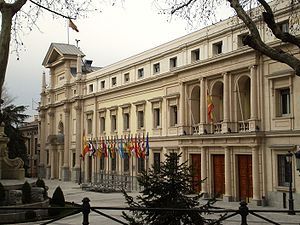
"The Spanish Senate", Spanish Navy Square, Madrid, Spain.
On May - 2 of 1814, the Deputies –of the Constitution of 1812-- had no place to meet.Then, they used the groundfloor of the Senate, in order to meet and discuss.Perhaps that is the reason why the Congress of Deputies is named “Lower House” (Cámara Baja), while the Senate is also named “Upper house” (Cámara Alta)..
The Constitution of 1837 gathered for the first time the denomination of the Senate for the upper house of Parliament.
In 1931, during the Second Republic in Spain, the Senate was abolished.
Currently, the Senators play a very important role: supervise decisions made at the Congress of Deputies.
The building of the Senate is very nice: it was an Augustinian Convent, from the Century XVI, concretely it was an old School of the Incarnation.
The old Plenary Hall, the Hall of Lost Steps and the Library are the most visited rooms.
The Plenary Hall has the English style, like in the English Parliament: some benches in front of others.
.jpg)
"The Plenary Hall", Senate Palace, Madrid, Spain.
Today, the Senate will continue with its Open Door.
Best regards,
Luis.
Sponsored by Costaluz Lawyers.
Please click down here:
.jpg)
 0
Like
Published at 11:18 AM Comments (0)
0
Like
Published at 11:18 AM Comments (0)
A Sensory Garden in Spain
Monday, December 3, 2012
Today is the International Day of Persons with Disabilities and therefore, I want to share a nice spanish initiative with you.It happened in 2011, but I have just known yesterday.
It is a new sensor system, placed in a part of the Park named "Castrelos", in Vigo (Southern Galicia, North-west of Spain).
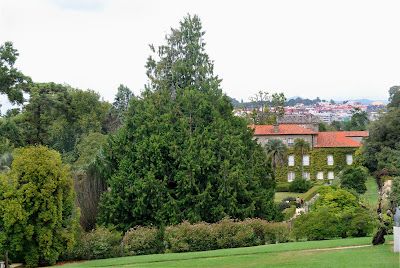
The Castrelos Park, Vigo, Galicia, North-west of Spain.
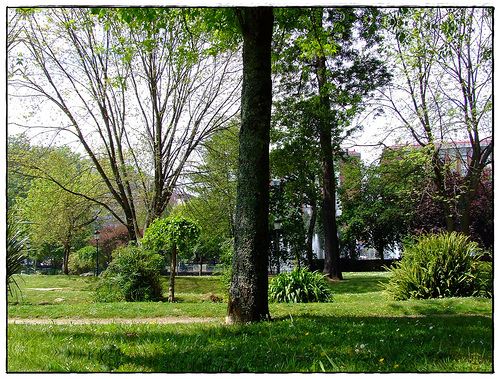
"Castrelos", Vigo, Galicia, North-west of Spain, by Nair la jefa, at flickr.com
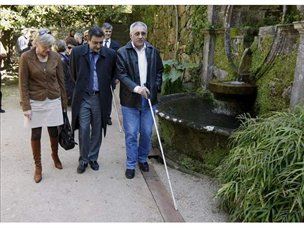
The Sensory Garden, Castrelos, Vigo.
To facilitate the tours, visitors will have a ribbon blind-defining the travel guide and information about the natural obstacles to walk in the park safely.
It also provides data on species or unique architectural elements of interest in the garden, according to a note from the local corporation.
One of the most notable are the trays installed along the route where visitors can perceive through leaves, tree branches and fruits, seasonal variations or different natural areas Castrelos Park.
Apart from the touch, visually impaired people can learn these gardens by ear with the different sounds of the park or through the nose, with aromas of plants and trees in the so called 'herb garden'.
I hope that you can go there or to another area in Galicia, because all of Galicia is very nice.
Kind regards,
Luis.
Sponsored by Costaluz Lawyers.
Please click down here:
 0
Like
Published at 11:15 AM Comments (1)
0
Like
Published at 11:15 AM Comments (1)
Spain against Parkinson
Saturday, December 1, 2012
A team of 13 Spanish researchers, with Francisco Pan Montojo to head, has discovered why and how pesticides are linked to Parkinson's disease.
In 2010, Francisco discovered that pesticides caused Parkinson without passing into the blood.
Now, Francisco and his team –including a woman researcher at the Autonomous University of Madrid— have investigated with laboratory mice.As Francisco explains, they have proven that pesticides alone acting on nerve cells in the intestine, can generate Parkinson and extend from the intestine to the brain.
In Europe, there are several pesticides allowed, even in Organic Farming.These pesticides accelerate the oxidation of cells, which release a protein that other cells absorb and they arrive to the brain, creating a degenerative disease with no cure.
Then, Parkinson has nothing to do with age and it does not start in brain but in intestine.
Francisco concludes that Parkinson is a combination between environmental toxins and individual capacity to address this external aggression.
So, this investigation opens three doors:
1 : Acting against pesticides.
2 : Early diagnosis.
3 : Possible Parkinson drugs.
I celebrate that my country, Spain, can offer a hope to the world.
Kind regards,
Luis.
Sponsored by Costaluz Lawyers.
Please click down here:
.jpg)
 0
Like
Published at 1:38 PM Comments (0)
0
Like
Published at 1:38 PM Comments (0)
Spam post or Abuse? Please let us know
|
|